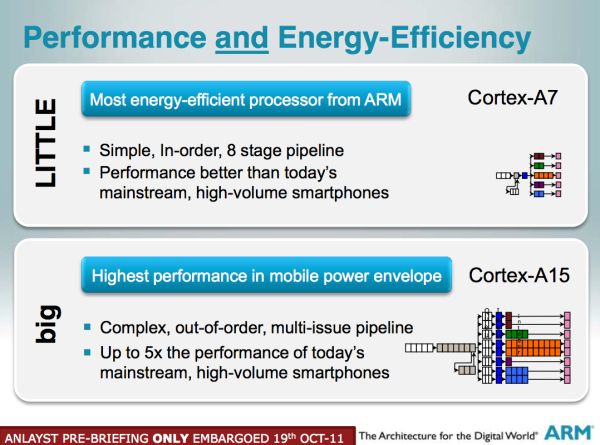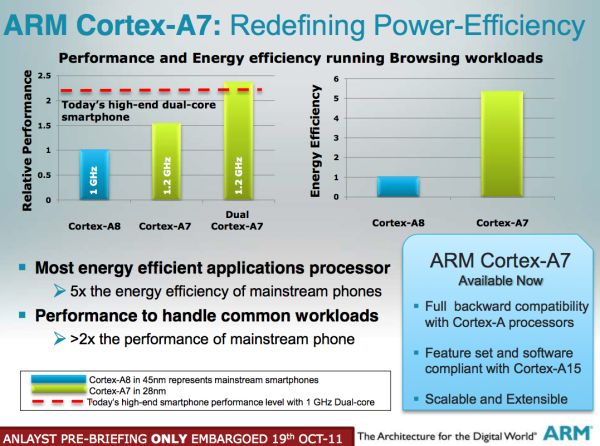ARM's Cortex A7: Bringing Cheaper Dual-Core & More Power Efficient High-End Devices
by Anand Lal Shimpi on October 19, 2011 12:31 PM EST- Posted in
- SoCs
- CPUs
- Arm
- Cortex A15
- Smartphones
- Mobile
- Cortex A7
- Tablets
How do you keep increasing performance in a power constrained environment like a smartphone without decreasing battery life? You can design more efficient microarchitectures, but at some point you’ll run out of steam there. You can transition to newer, more power efficient process technologies but even then progress is very difficult to come by. In the past you could rely on either one of these options to deliver lower power consumption, but these days you have to rely on both - and even then it’s potentially not enough. Heterogeneous multiprocessing is another option available - put a bunch of high performance cores alongside some low performance but low power cores and switch between them as necessary.
NVIDIA recently revealed it was doing something similar to this with its upcoming Tegra 3 (Kal-El) SoC. NVIDIA outfitted its next-generation SoC with five CPU cores, although only a maximum of four are visible to the OS. If you’re running light tasks (background checking for email, SMS/MMS, twitter updates while your phone is locked) then a single low power Cortex A9 core services those needs while the higher performance A9s remain power gated. Request more of the OS (e.g. unlock your phone and load a webpage) and the low power A9 goes to sleep and the 4 high performance cores wake up.
While NVIDIA’s solution uses identical cores simply built using different transistors (LP vs. G), the premise doesn’t change if you move to physically different cores. For NVIDIA, ARM didn’t really have a suitable low power core thus it settled on a lower power Cortex A9. Today, ARM is expanding the Cortex family to include a low power core that can either be used by itself or as an ISA-compatible companion core in Cortex A15 based SoCs. It’s called the ARM Cortex A7.
Architecture
Starting with the Cortex A9, ARM moved to an out-of-order execution core (instructions can be reordered around dependencies for improved parallelism) - a transition that we saw in the x86 space back in the days of the Pentium Pro. The Cortex A15 continues the trend as an OoO core but increases the width of the machine. The Cortex A7 however takes a step back and is another simple in-order core capable of issuing up to two instructions in parallel. This should sound a lot like the Cortex A8, however the A7 is different in a number of areas.
The A8 is a very old design with work originally beginning on the core in 2003. Although ARM offered easily synthesizable versions of the core, in order to hit higher clock speeds you needed to include a lot of custom logic. The custom design requirements on A8 not only lengthened time to market but also increased development costs, limiting the A8’s overall reach. The Cortex A7 on the other hand would have to be fully synthesizable while being able to deliver good performance. ARM could leverage process technology advancements over the past few years to deliver clock speed and competitive power consumption, but it needed a revised architecture to meet the cost and time to market requirements.
The Cortex A7 features an 8-stage integer pipeline and is capable of dual-issue. Unlike the Cortex A8 however, the A7 cannot dual-issue floating point or NEON instructions. There are other instructions that turn the A7 into a single-issue machine as well. The integer execution cluster is quite similar to the Cortex A8, although the FPU is fully pipelined and more compact than its older brother.
Limiting issue width for more complex instructions helps keep die size in check, which was a definite goal for the core. ARM claims a single Cortex A7 core will measure only 0.5mm2 on a 28nm process. On an equivalent process node ARM expects customers will be able to implement an A7 in 1/3 - 1/2 the die area of a Cortex A8. As a reference, an A9 core uses about the same (if not a little less) die area as an A8 while an A15 is a bit bigger than both.
| Architecture Comparison | |||||||||
| ARM11 | ARM Cortex A7 | ARM Cortex A8 | ARM Cortex A9 | Qualcomm Scorpion | Qualcomm Krait | ||||
| Decode | single-issue | partial dual-issue | 2-wide | 2-wide | 2-wide | 3-wide | |||
| Pipeline Depth | 8 stages | 8 stages | 13 stages | 8 stages | 10 stages | 11 stages | |||
| Out of Order Execution | N | N | N | Y | Partial | Y | |||
| Pipelined FPU | Y | Y | N | Y | Y | Y | |||
| NEON | N/A | Y (64-bit wide) | Y (64-bit wide) | Optional MPE (64-bit wide) | Y (128-bit wide) | Y (128-bit wide) | |||
| Process Technology | 90nm | 40nm/28m | 65nm/45nm | 40nm | 40nm | 28nm | |||
| Typical Clock Speeds | 412MHz | 1.5GHz (28nm) | 600MHz/1GHz | 1.2GHz | 1GHz | 1.5GHz | |||
Despite the limited dual issue capabilities, ARM is hoping for better performance per clock and better overall performance out of the Cortex A7 compared to the Cortex A8. Branch prediction performance is improved partly by using a more modern predictor, and partly because the shallower pipeline lessens the mispredict penalty. The Cortex A7 features better prefetching algorithms to help improve efficiency. ARM also includes a very low latency L2 cache (10 cycles) with its Cortex A7 design, although actual latency can be configured by the partner during implementation.
Note that in decoding bound scenarios, the Cortex A7 will offer the same if not lower performance than a Cortex A8 due to its limited dual-issue capabilities. The mildly useful DMIPS/MHz ratings of ARM’s various cores are below:
| Estimated Core Performance | |||||||||
| ARM11 | ARM Cortex A7 | ARM Cortex A8 | ARM Cortex A9 | Qualcomm Scorpion | Qualcomm Krait | ||||
| DMIPS/MHz | 1.25 | 1.9 | 2.0 | 2.5 | 2.1 | 3.3 | |||
The big news is the Cortex A7 is 100% ISA compatible with the Cortex A15, this includes the new virtualization instructions, integer divide support and 40-bit memory addressing. Any code running on an A15 can run on a Cortex A7, just slower. This is a very important feature as it enables SoC vendors to build chips with both Cortex A7 and Cortex A15 cores, switching between them depending on workload requirements. ARM calls this a big.LITTLE configuration.












75 Comments
View All Comments
sarge78 - Wednesday, October 19, 2011 - link
http://www.arm.com/products/processors/cortex-a/co...The Cortex-A5 processor is the smallest, lowest power ARM multicore processor capable of delivering the Internet to the widest possible range of devices: from ultra low cost handsets, feature phones and smart mobile devices, to pervasive embedded, consumer and industrial devices.The Cortex-A5 processor is fully application compatible with the Cortex-A8, Cortex-A9, and Cortex-A15 processors, enabling immediate access to an established developer and software ecosystem including Android, Adobe Flash, Java Platform Standard Edition (Java SE), JavaFX, Linux, Microsoft Windows Embedded, Symbian and Ubuntu. Cortex-A5 benefits include:
- Full application compatibility with the Cortex-A8, Cortex-A9, and Cortex-A15 processors
- Provides a high-value migration path for the large number of existing ARM926EJ-S™ and ARM1176JZ-S™ processor licensees.
- 1/3 the power and area of Cortex-A9, with full instruction set compatibility.
Why didn't nVidia use a cortex A5 for Kal-El?
ET - Thursday, October 20, 2011 - link
The Cortex-A5 was announced in 2009 and hasn't apparently there hasn't been much demand for it (according to one article). At 1.57 DMIPS / MHz (according to the ARM page) it's significantly weaker than the A8, and I figure that was one problem. My guess is that the Cortex-A7 is a response to that, with higher clock rates and performance that should surpass A8 in most cases.Lucian Armasu - Saturday, October 22, 2011 - link
But it wasn't supposed to replace Cortex A8, but ARM11, which is still in all low-end Android phones today, and I hate it. Cortex A5 with close to Cortex A8 performance, and 3x more efficient, would've been a really nice replacement for ARM11.bjacobson - Wednesday, October 19, 2011 - link
wait, so why is the A7 better if 7 is a smaller number than 8? O.oManabu - Sunday, October 23, 2011 - link
Because 8 is an even number, and ARM was cursed so that every even numbered architeture they make is bad. You don't hear about ARM6, ARM8 or ARM10, but ARM7, ARM9 and ARM11 are still very much alive everywhere (low end, Tegra2, etc). The cortex A8 was a bit more sucessfull because the new instruction-set and raw power, but still was a bad desing. We probably won't be hearing about any new SoC using it in the future.Cortex A9, A5, A15 and now A7. ARM is on a roll now, as they stopped being stubborn and are side-stepping the even numbers. ;-)
The Cortex A8 is bigger and theorically faster clock for clock than the Cortex A7, even if in practice it will likely be slower because it laugably slow FPU, lower efficiency and core counts. And as it isn't faster than A9, 7 is the logical number to use.
iwod - Thursday, October 20, 2011 - link
Anand, could you do an article on xx bit CPU. With 64 Bit x86 CPU we get two major benefits, memory addressing space, and extra register for faster performance. But other then that, how many program actually uses 64bit Integer and Floating Point?ARM A7 / A15 seems to provide 40bit address, 1TB of Memory or 250 times more then current 4GB limit. I remember Intel also had 40bit memory addressing but require Software, OS, BIOS working together and it doesn't work very well on software development. Is this still the case with ARM?
mihaimm - Thursday, October 20, 2011 - link
I can't wait to boot Ubuntu on those. With little tweaks we'll be able to have nice threads go to A7 and others to A15 automatically. Quad cores at 1-1.5 GHz should be enough for for mostly anything on Linux. And if we get it packaged with 543MP2 (and good drivers) this would kill x86.introiboad - Thursday, October 20, 2011 - link
Even better than 543MP2, if it runs Ubuntu and by the time this comes to market, we'll have Rogue.french toast - Thursday, October 20, 2011 - link
hey i posted i comment earlier, replying to someone else, asking a question or two, nothing impolite or anythng like that, and when i have looked back to see if i got an answer my comment has been removed!?? why??Snowstorms - Thursday, October 20, 2011 - link
these guys are so close to competing for desktop x86 space, they are already down to 28nm and are using the exact same ASML as Intel and AMD